Numerical Simulation of Vertical Well Depressurization-Assisted In Situ Heating Mining in a Class 1-Type Hydrate Reservoir
Abstract
:1. Introduction
2. Methodology
2.1. Site Description
2.2. Simulator
- Multi-components and -phases.
- 2.
- Mass conservation equation.
- 3.
- Energy conservation equation.
2.3. Model Construction
2.4. Model Initialization
2.5. Model Validation
3. Results and Analysis
3.1. Gas and Water Production
3.2. Reservoir Physical Property Evolution
3.2.1. Pore Pressure
3.2.2. Reservoir Temperature
3.2.3. Hydrate and Gas Saturation
4. Discussion
4.1. Effects of Heating Power
4.2. Effects of Heating Location
4.3. Effects of Heating Time
4.4. Effects of Heating Mode
5. Conclusions
- (1)
- In situ electric heating has a good effect on increasing production capacity, and its main mechanism is to promote the dissociation of hydrates and eliminate secondary hydrates. When the vertical wellbore with a completion length of 70 m is deployed in the center of the model and continuously mined for 1080 days under a production pressure difference of 4 MPa, the Vg of the whole wellbore heating case is increased to 118.56% compared with the case without heating.
- (2)
- When intermittent heating is applied to the local wellbore (15 m) located in the TPL (with an interval of 30 days) and stop heating in advance at 480 days, there is no significant difference in the Vg after 1080 days of production compared to the whole wellbore heating, and the cumulative heat input is only 4.76% of the whole wellbore heating. We recommend considering intermittent heating of the local wellbore and stopping heating in advance during vertical well depressurization, which can greatly save heating energy consumption while increasing production capacity.
- (3)
- Intermittent heating of the local wellbore may be an effective strategy to maintain high production capacity while reducing energy consumption during vertical well depressurization. In the future, we will combine methods such as complex structured wells and reservoir reconstruction to further study the effects of intermittent heating of local wellbore on natural gas and water production in different types of hydrate reservoirs.
Author Contributions
Funding
Institutional Review Board Statement
Informed Consent Statement
Data Availability Statement
Conflicts of Interest
Nomenclature
| Symbols | |
| mass accumulation of component κ, (kg/m3) | |
| mass flux of component κ, kg/(m2·s) | |
| sink/source of component κ, kg/(m3·s) | |
| energy accumulation (J/m3) | |
| energy flux, J/(m2·s) | |
| sink/source of heat, J/(m3·s) | |
| volume (m3) | |
| surface area (m2) | |
| t | time (s) |
| KΘ | composite thermal conductivity |
| kdry | dry thermal conductivity |
| kwe | wet thermal conductivity |
| φ | prosity |
| λI | average thermal conductivity of ice |
| Pcap cap | capillary pressure (Pa) |
| P0 | initial capillary pressure (Pa) |
| S* | saturation for capillary pressure |
| Sβ | saturation of phase β |
| SmxA | maximum reference aqueous saturation of capillary |
| SirA | irreducible saturation of aqueous phase |
| krβ | relative permeability of phase β |
| SirG | irreducible saturation of gas phase |
| nA | permeability reduction index for aqueous phase |
| nG | permeability reduction index for gas phase |
| λ | porosity distribution index |
| FϕS | coefficient of permeability reduction |
| k | effective permeability of the sediment |
| k0 | inherent permeability of the sediment |
| φ | effective porosity of the sediment |
| φ0 | original porosity of the sediment |
| φc | critical porosity |
| n | permeability reduction index |
| EROIcustom | energy output and input ratio (dimensionless) |
| EO | calorific value of increased production (MJ) |
| EI | additional heat to drive production (MJ) |
| Abbreviations | |
| SCS | South China Sea |
| OB | overburden layer |
| UB | underburden layer |
| GHBL | gas hydrate bearing layer |
| TPL | three-phase layer |
| FGL | free gas layer |
| NGH | natural gas hydrate |
| WWH | whole wellbore heating |
| LWH | local wellbore heating |
| CH | continuous heating |
| SHIA | stop heating in advance |
| IH | intermittent heating |
References
- Sloan, E.D. Fundamental principles and applications of natural gas hydrates. Nature 2003, 426, 353–359. [Google Scholar] [CrossRef]
- Boswell, R. Is gas hydrate energy within reach? Science 2009, 325, 957–958. [Google Scholar] [CrossRef]
- Chong, Z.; Yang, S.; Babu, P.; Linga, P.; Li, X. Review of natural gas hydrates as an energy resource: Prospects and challenges. Appl. Energy 2016, 162, 1633–1652. [Google Scholar] [CrossRef]
- Boswell, R.; Collett, T.S. Current perspectives on gas hydrate resources. Energy Environ. Sci. 2011, 4, 1206–1215. [Google Scholar] [CrossRef]
- Sloan, E.D.; Koh, C.A. Clathrate Hydrates of Natural Gases; CRC Press: New York, NY, USA, 2008; pp. 2–3. [Google Scholar]
- Yamamoto, K.; Terao, Y.; Fujii, T.; Ikawa, T.; Seki, M.; Matsuzawa, M.; Kanno, T. Operational Overview of the First Offshore Production Test of Methane Hydrates in the Eastern Nankai Trough. In Proceedings of the Offshore Technology Conference, Houston, TX, USA, 5–8 May 2014. [Google Scholar]
- Yamamoto, K.; Wang, X.X.; Tamaki, M.; Suzuki, K. The second offshore production of methane hydrate in the Nankai Trough and gas production behavior from a heterogeneous methane hydrate reservoir. RSC Adv. 2019, 9, 25987–26013. [Google Scholar] [CrossRef] [PubMed]
- Li, J.; Ye, J.; Qin, X.; Qiu, H.; Wu, N.; Lu, H.; Xie, W.; Lu, J.; Peng, F.; Xu, Z.; et al. The first offshore natural gas hydrate production test in South China Sea. China Geol. 2018, 1, 5–16. [Google Scholar] [CrossRef]
- Ye, J.; Qin, X.; Xie, W.; Lu, H.; Ma, B.; Qiu, H.; Liang, J.; Lu, J.; Kuang, Z.; Lu, C.; et al. The second natural gas hydrate production test in the South China Sea. China Geol. 2020, 3, 197–209. [Google Scholar] [CrossRef]
- Okwananke, A.; Hassanpouryouzband, A.; Farahani, M.; Yang, J.; Tohidi, B.; Chuvilin, E.; Istomin, V.; Bukhanov, B. Methane recovery from gas hydrate-bearing sediments: An experimental study on the gas permeation characteristics under varying pressure. J. Pet. Sci. Eng. 2019, 180, 435–444. [Google Scholar] [CrossRef]
- Zhang, L.; Sun, L.; Sun, M.; Lv, X.; Dong, H.; Miao, Y.; Yang, L.; Song, Y.; Zhao, J. Analyzing spatially and temporally visualized formation behavior of methane hydrate in unconsolidated porous media. Magn. Reson. Imaging 2019, 61, 224–230. [Google Scholar] [CrossRef] [PubMed]
- Farahani, M.; Guo, X.; Zhang, L.; Yang, M.; Hassanpouryouzband, A.; Zhao, J.; Yang, J.; Song, Y.; Tohidi, B. Effect of thermal formation/dissociation cycles on the kinetics of formation and pore-scale distribution of methane hydrates in porous media: A magnetic resonance imaging study. Sustain. Energy Fuels 2021, 5, 1567–1583. [Google Scholar] [CrossRef]
- Wu, N.; Li, Y.; Wan, Y.; Sun, J.; Huang, L.; Mao, P. Prospect of marine natural gas hydrate stimulation theory and technology system. Nat. Gas Ind. B 2021, 40, 173–187. [Google Scholar] [CrossRef]
- Zheng, R.; Li, S.; Li, X. Sensitivity analysis of hydrate dissociation front conditioned to depressurization and wellbore heating. Mar. Pet. Geol. 2018, 91, 631–638. [Google Scholar] [CrossRef]
- Zhao, E.; Hou, J.; Ji, Y.; Liu, Y.; Bai, Y. Enhancing gas production from Class II hydrate deposits through depressurization combined with low-frequency electric heating under dual horizontal wells. Energy 2021, 233, 121137. [Google Scholar] [CrossRef]
- Xu, T.; Zhang, Z.; Li, S.; Li, X.; Lu, C. Numerical evaluation of Gas hydrate production performance of the depressurization and backfilling with an in situ supplemental heat Method. ACS Omega 2021, 6, 12274–12286. [Google Scholar] [CrossRef] [PubMed]
- Li, B.; Ye, Y.; Zhang, T.; Wan, Q. Numerical Investigation into the Gas Production from Hydrate Deposit under Various Thermal Stimulation Modes in a Multi-Well System in Qilian Mountain. Entropy 2021, 23, 800. [Google Scholar] [CrossRef] [PubMed]
- Zhao, E.; Hou, J.; Du, Q.; Liu, Y.; Ji, Y.; Bai, Y. Numerical modeling of gas production from methane hydrate deposits using low-frequency electrical heating assisted depressurization method. Fuel 2021, 290, 120075. [Google Scholar] [CrossRef]
- Liu, S.; Li, H.; Wang, B.; Sun, B. Accelerating gas production of the depressurization-induced natural gas hydrate by electrical heating. J. Pet. Sci. Eng. 2022, 208, 109735. [Google Scholar] [CrossRef]
- Zhao, E.; Hou, J.; Ji, Y.; Liu, Y.; Bai, Y. Energy recovery behavior of low-frequency electric heating assisted depressurization in Class 1 hydrate deposits. Fuel 2022, 309, 122185. [Google Scholar] [CrossRef]
- Wang, B.; Liu, S.; Wang, P. Microwave-assisted high-efficient gas production of depressurization-induced methane hydrate exploitation. Energy 2022, 247, 123353. [Google Scholar] [CrossRef]
- Zhang, Q.; Wang, Y. Numerical Simulations of Combined Brine Flooding with Electrical Heating–Assisted Depressurization for Exploitation of Natural Gas Hydrate in the Shenhu Area of the South China Sea. Front. Earth Sci. 2022, 10, 843521. [Google Scholar] [CrossRef]
- Zhang, Q.; Wang, Y. Comparisons of different electrical heating assisted depressurization methods for developing the unconfined hydrate deposits in Shenhu area. Energy 2023, 269, 126828. [Google Scholar] [CrossRef]
- Moridis, G.; Kowalsky, M.; Pruess, K. TOUGH+ Hydrate V1.0 User’s Manual; Report LBNL-0149E; Lawrence Berkeley National Laboratory: Berkeley, CA, USA, 2008. [Google Scholar]
- Uddin, M.; Wright, F.; Coombe, D. Numerical study of gas evolution and transport behaviours in natural gas-hydrate reservoirs. J. Can. Pet. Technol. 2011, 50, 70–89. [Google Scholar] [CrossRef]
- Masuda, Y.; Yamamoto, K.; Tadaaki, S.; Ebinuma, T.; Nagakubo, S. Japan’s methane hydrate R&D program progresses to phase 2. Nat. Gas Oil 2018, 304, 285–4541. [Google Scholar]
- White, M.; Wurstner, S.; McGrail, B. Numerical studies of methane production from Class 1 gas hydrate accumulations enhanced with carbon dioxide injection. Mar. Pet. Geol. 2011, 28, 546–560. [Google Scholar] [CrossRef]
- Zhang, W.; Liang, J.; Lu, J.; Wei, J.; Su, P.; Fang, Y.; Guo, Y.; Yang, S.; Zang, G. Accumulation features and mechanisms of high saturation natural gas hydrate in shenhu area, northern south china sea. Pet. Explor. Dev. 2017, 44, 708–719. [Google Scholar] [CrossRef]
- Su, P.; He, J.; Liang, J.; Zhang, W. Natural gas hydrate migration and accumulation system and its controlling factors on northern deep water slope of the South China Sea. Mar. Geol. Front. 2017, 33, 1–10. [Google Scholar]
- Hao, Y.; Yang, F.; Wang, J.; Fan, M.; Li, S.; Yang, S.; Wang, C.; Xiao, X. Dynamic analysis of exploitation of different types of multilateral wells of a hydrate reservoir in the South China sea. Energy Fuels 2022, 36, 6083–6095. [Google Scholar] [CrossRef]
- Su, Z.; Moridis, G.J.; Zhang, K.; Wu, N. A huff-and-puff production of gas hydrate deposits in Shenhu area of South China Sea through a vertical well. J. Pet. Sci. Eng. 2012, 86–87, 54–61. [Google Scholar] [CrossRef]
- Yin, Z.; Moridis, G.; Chong, Z.R.; Linga, P. Effectiveness of multi-stage cooling processes in improving the CH4-hydrate saturation uniformity in sandy laboratory samples. Appl. Energy 2019, 250, 729–747. [Google Scholar] [CrossRef]
- Zhang, K.; Moridis, G.; Wu, Y.; Pruess, K. A domain decomposition approach for large-scale simulations of flow processes in hydrate-bearing geologic media. In Proceedings of the 6th International Conference on Gas Hydrates (ICGH 2008), Vancouver, BC, Canada, 6–10 July 2008. [Google Scholar]
- Kowalsky, M.; Moridis, G. Comparison of kinetic and equilibrium reaction models in simulating gas hydrate behavior in porous media. Energy Convers. Manag. 2007, 48, 1850–1863. [Google Scholar] [CrossRef]
- Yuan, Y.; Xu, T.; Xin, X.; Gong, Y.; Li, B. Enhanced gas production from clayey-silt hydrate reservoirs based on near-well reservoir reconstruction using the high-pressure jet grouting technology. J. Nat. Gas Sci. Eng. 2021, 94, 104121. [Google Scholar] [CrossRef]
- Yuan, Y.; Xu, T.; Jin, C.; Zhu, H.; Gong, Y.; Wang, F. Multiphase flow and mechanical behaviors induced by gas production from clayey-silt hydrate reservoirs using horizontal well. J. Clean. Prod. 2021, 328, 129578. [Google Scholar] [CrossRef]
- Zhang, J.; Yin, Z.; Li, Q.; Li, S.; Wang, Y.; Li, X. Comparison of fluid production between excess-gas and excess-water hydrate-bearing sediments under depressurization and its implication on energy recovery. Energy 2023, 282, 128315. [Google Scholar] [CrossRef]
- Yu, T.; Guan, G.; Wang, D.; Song, Y.; Abudula, A. Numerical investigation on the long-term gas production behavior at the 2017 Shenhu methane hydrate production site. Appl. Energy 2021, 285, 116466. [Google Scholar] [CrossRef]
- Sun, J.; Zhang, L.; Ning, F.; Lei, H.; Liu, T.; Hu, G.; Lu, H.; Lu, J.; Liu, C.; Jiang, G.; et al. Production potential and stability of hydrate-bearing sediments at the site GMGS3-W19 in the South China Sea: A preliminary feasibility study. Mar. Pet. Geol. 2017, 86, 447–473. [Google Scholar] [CrossRef]
- Yuan, Y.; Xu, T.; Xin, X.; Xia, Y. Multiphase Flow Behavior of Layered Methane Hydrate Reservoir Induced by Gas Production. Geofluids 2017, 2017, 7851031. [Google Scholar] [CrossRef]
- Moridis, G.; Kowalsky, M.; Pruess, K. Depressurization-induced gas production from class 1 hydrate deposits. SPE Reserv. Eval. Eng. 2007, 10, 458–481. [Google Scholar] [CrossRef]
- Feng, Y.; Chen, L.; Suzuki, A.; Kogawa, T.; Okajima, J.; Komiya, A.; Maruyama, S. Enhancement of gas production from methane hydrate reservoirs by the combination of hydraulic fracturing and depressurization method. Energy Convers. Manag. 2019, 184, 194–204. [Google Scholar] [CrossRef]
- Moridis, G.J.; Reagan, M.T.; Kim, S.J.; Seol, Y.; Zhang, K. Evaluation of the Gas Production Potential of Marine Hydrate De-posits in the Ulleung Basin of the Korean East Sea. SPE J. 2007, 14, 759–781. [Google Scholar] [CrossRef]
- Sun, Y.; Ma, X.; Guo, W.; Jia, R.; Li, B. Numerical simulation of the short- and long-term production behavior of the first offshore gas hydrate production test in the South China Sea. J. Pet. Sci. Eng. 2019, 181, 106196. [Google Scholar] [CrossRef]
- Ma, X.; Sun, Y.; Liu, B.; Guo, W.; Jia, R.; Li, B.; Li, S. Numerical study of depressurization and hot water injection for gas hydrate production in China’s first offshore test site. J. Nat. Gas Sci. Eng. 2020, 83, 103530. [Google Scholar] [CrossRef]
- Cao, X.; Sun, J.; Qin, F.; Ning, F.; Mao, P.; Gu, Y.; Li, Y.; Zhang, H.; Yu, Y.; Wu, N. Numerical analysis on gas production performance by using a multilateral well system at the first offshore hydrate production test site in the Shenhu area. Energy 2023, 270, 126690. [Google Scholar] [CrossRef]
- Qin, X.; Liang, Q.; Yang, L.; Qiu, H.; Xie, W.; Liang, J.; Lu, J.; Lu, C.; Lu, H.; Ma, B.; et al. The response of temperature and pressure of hydrate reservoirs in the first gas hydrate production test in South China Sea. Appl. Energy 2020, 278, 115649. [Google Scholar] [CrossRef]
- Murphy, D.; Hall, C.; Dale, M.; Cleveland, C. Order from chaos: A preliminary protocol for determining the EROI of fuels. Sustainability 2011, 3, 1888–1907. [Google Scholar] [CrossRef]
- Hu, Y.; Hall, C.; Wang, J.; Feng, L.; Poisson, A. Energy Return on Investment (EROI) of China’s conventional fossil fuels: Historical and future trends. Energy 2013, 54, 352–364. [Google Scholar] [CrossRef]
- Kong, Z.; Jiang, Q.; Dong, X.; Wang, J.; Wan, X. Estimation of China’s production efficiency of natural gas hydrates in the South China Sea. J. Clean. Prod. 2018, 203, 1–12. [Google Scholar] [CrossRef]
- Jin, G.; Peng, Y.; Liu, L.; Su, Z.; Liu, J.; Li, T.; Wu, D. Enhancement of gas production from low-permeability hydrate by radially branched horizontal well: Shenhu Area, South China Sea. Energy 2022, 253, 124129. [Google Scholar] [CrossRef]
- Li, S.; Zheng, R.; Xu, X.; Chen, Y. Dissociation of methane hydrate by hot brine. Pet. Sci. Technol. 2015, 33, 671–677. [Google Scholar] [CrossRef]
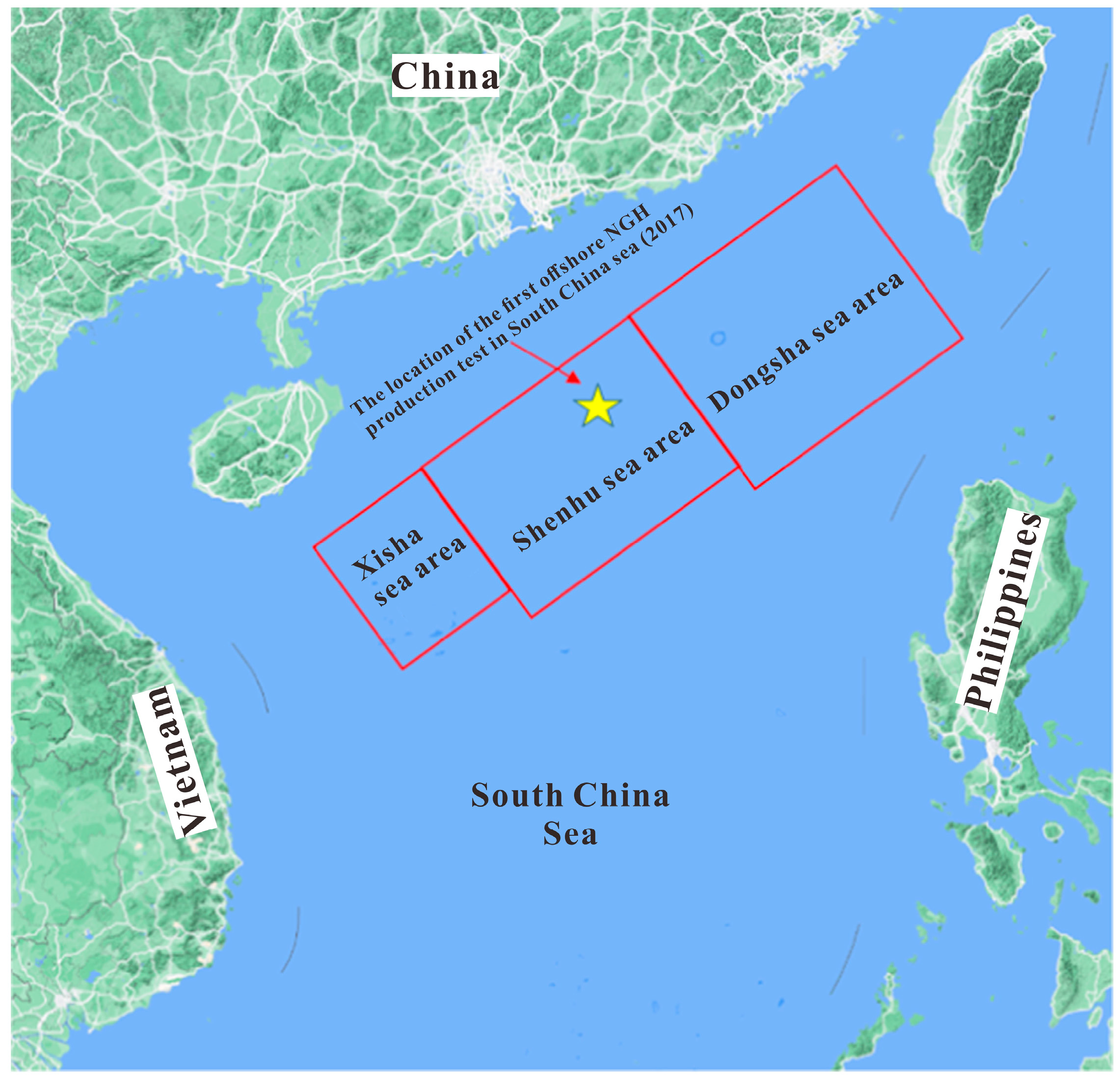
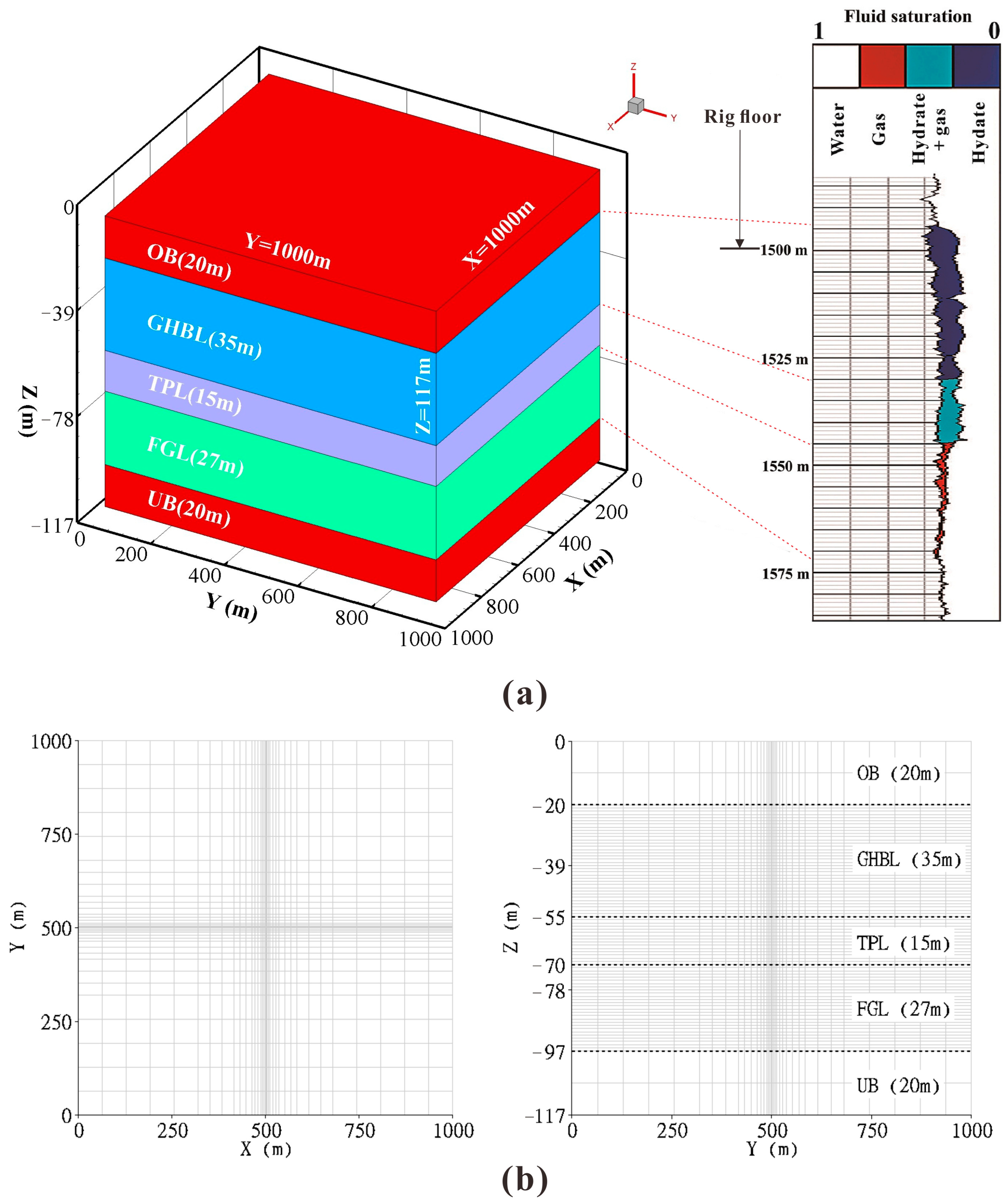

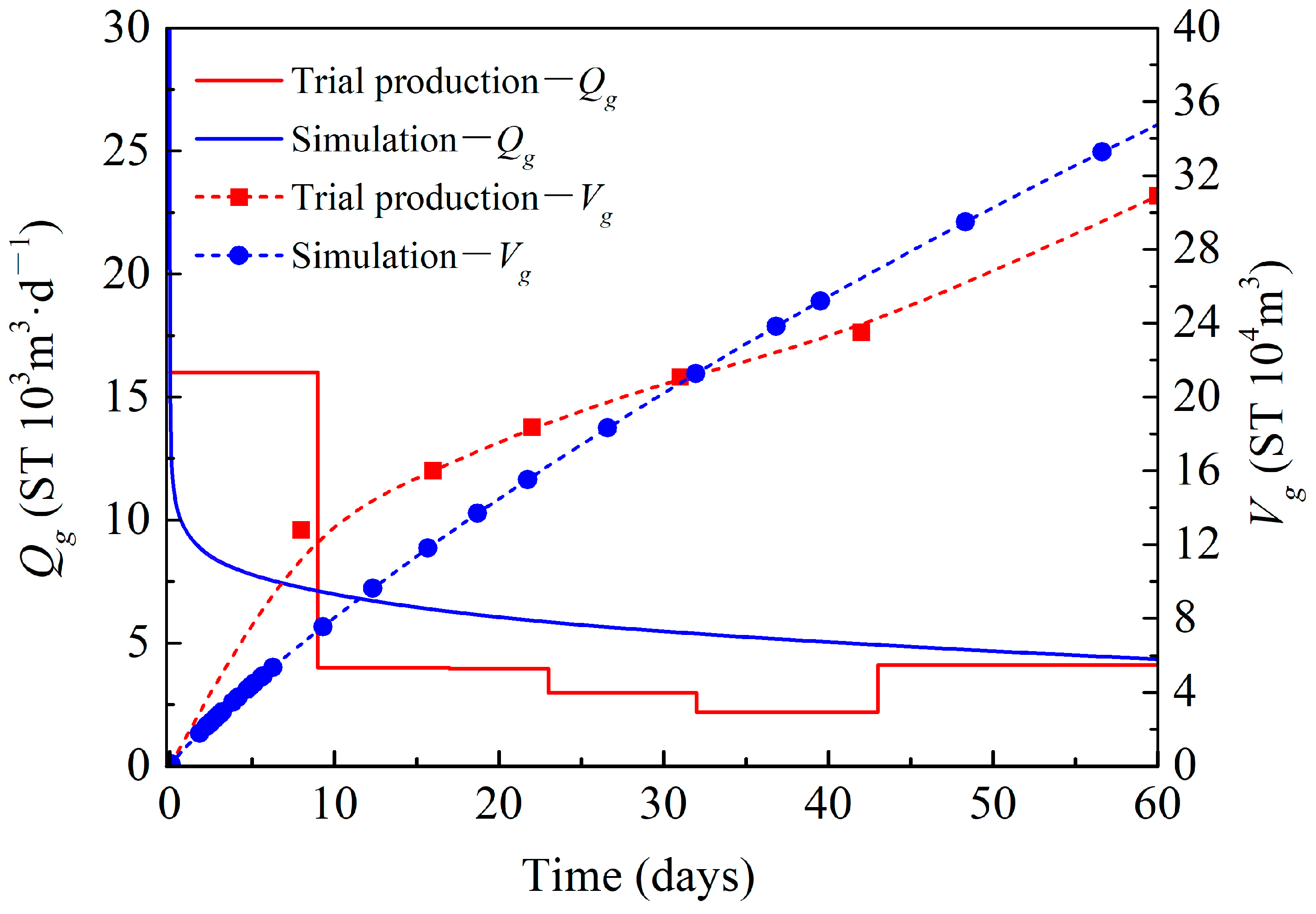
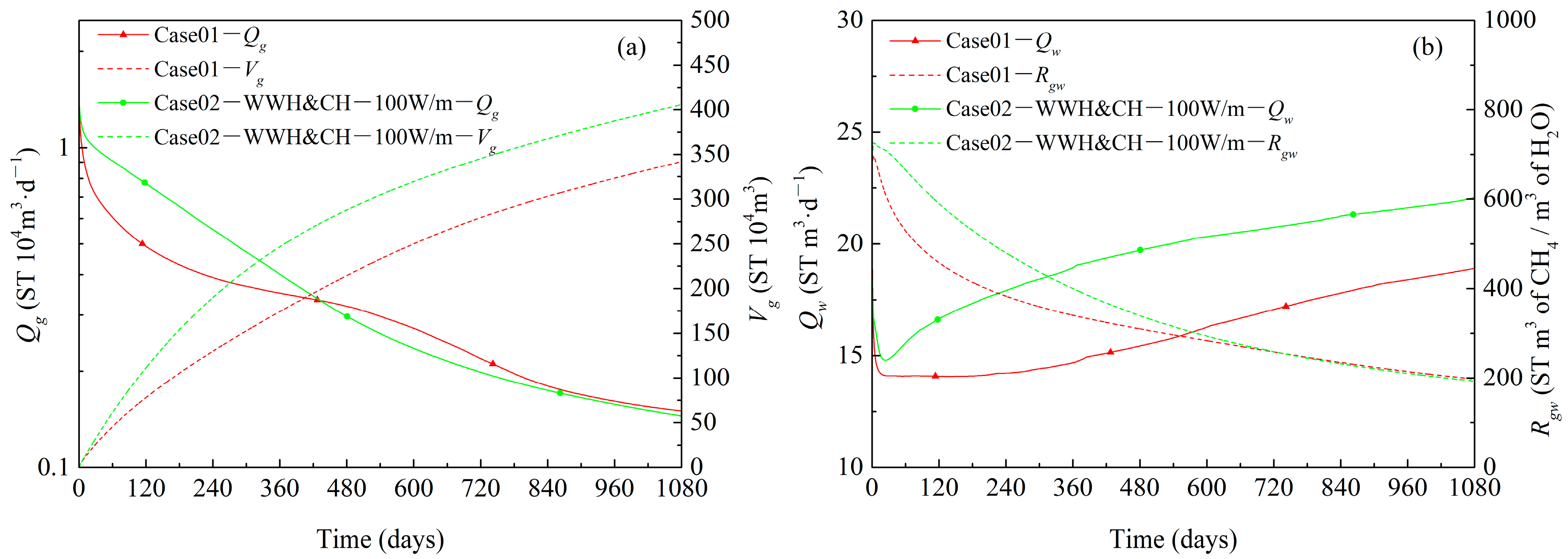
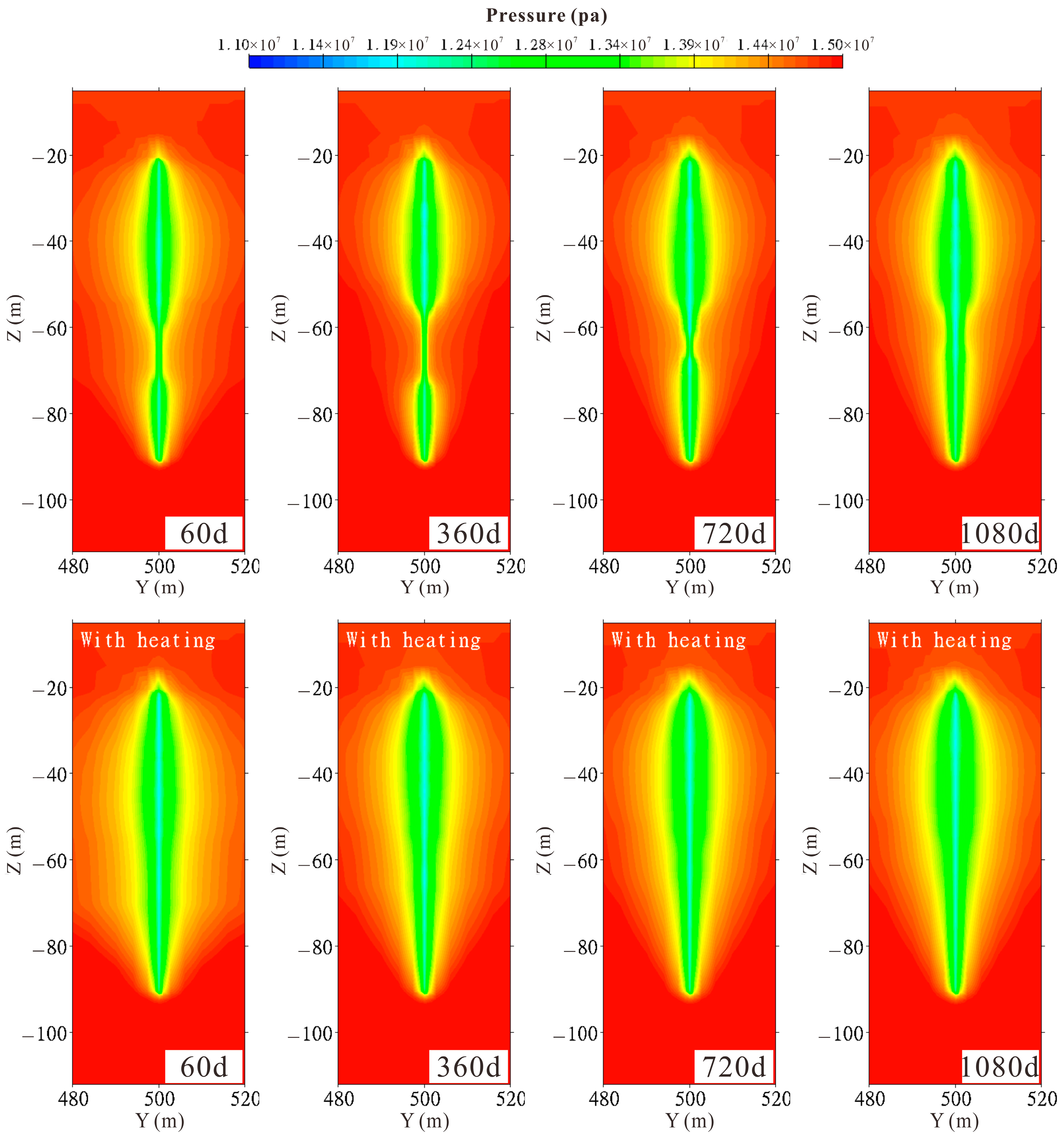
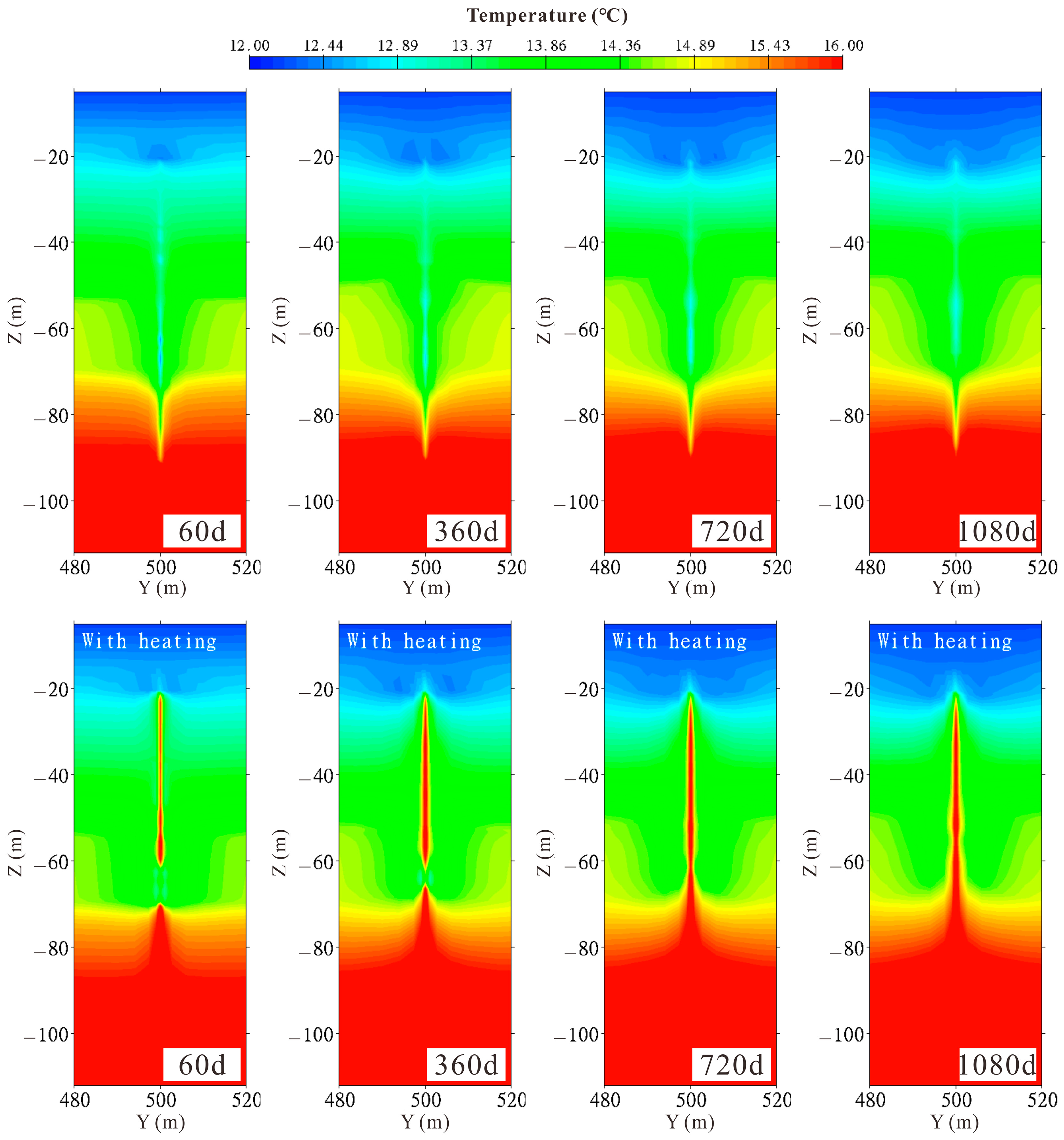
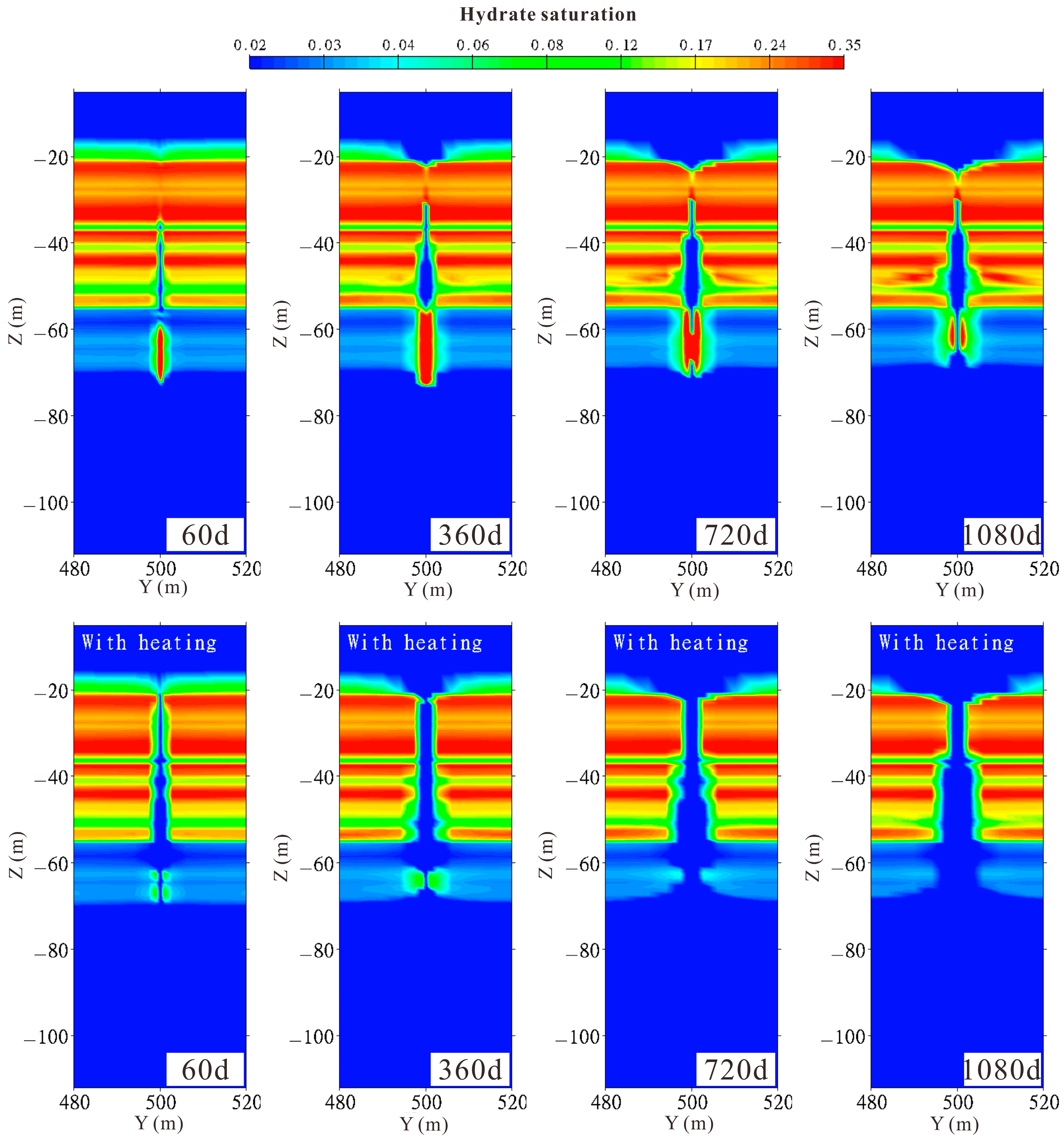

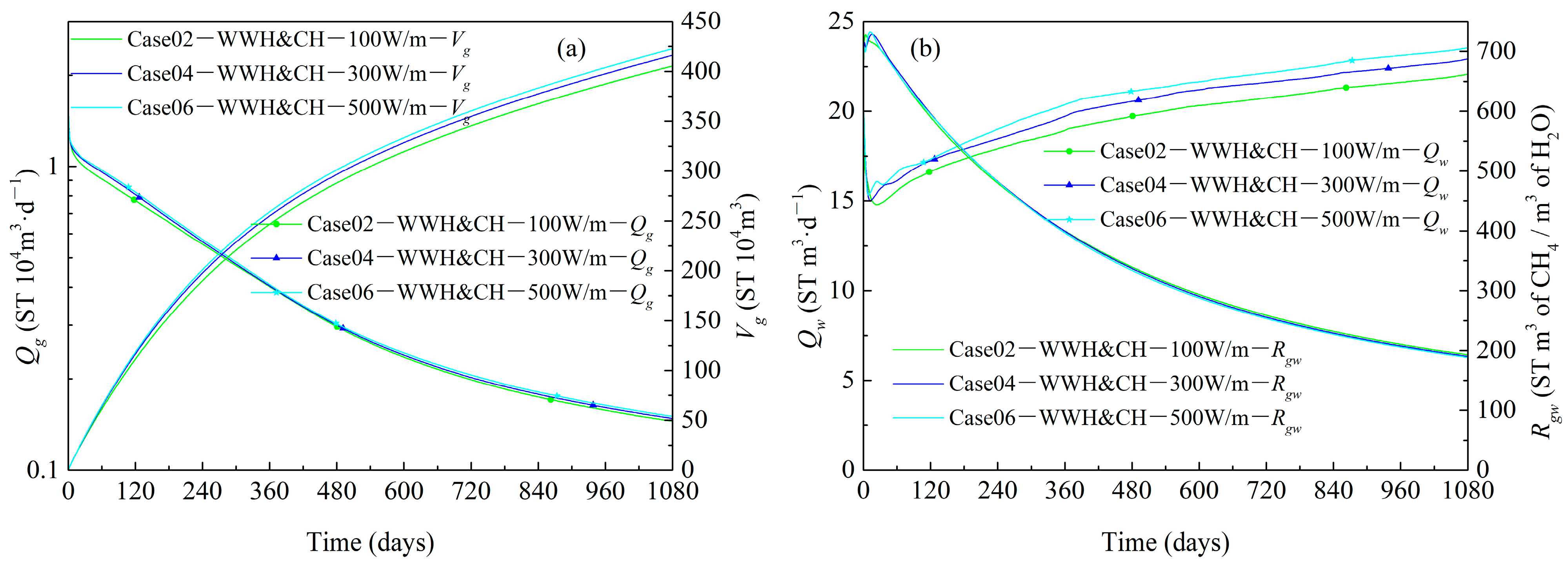

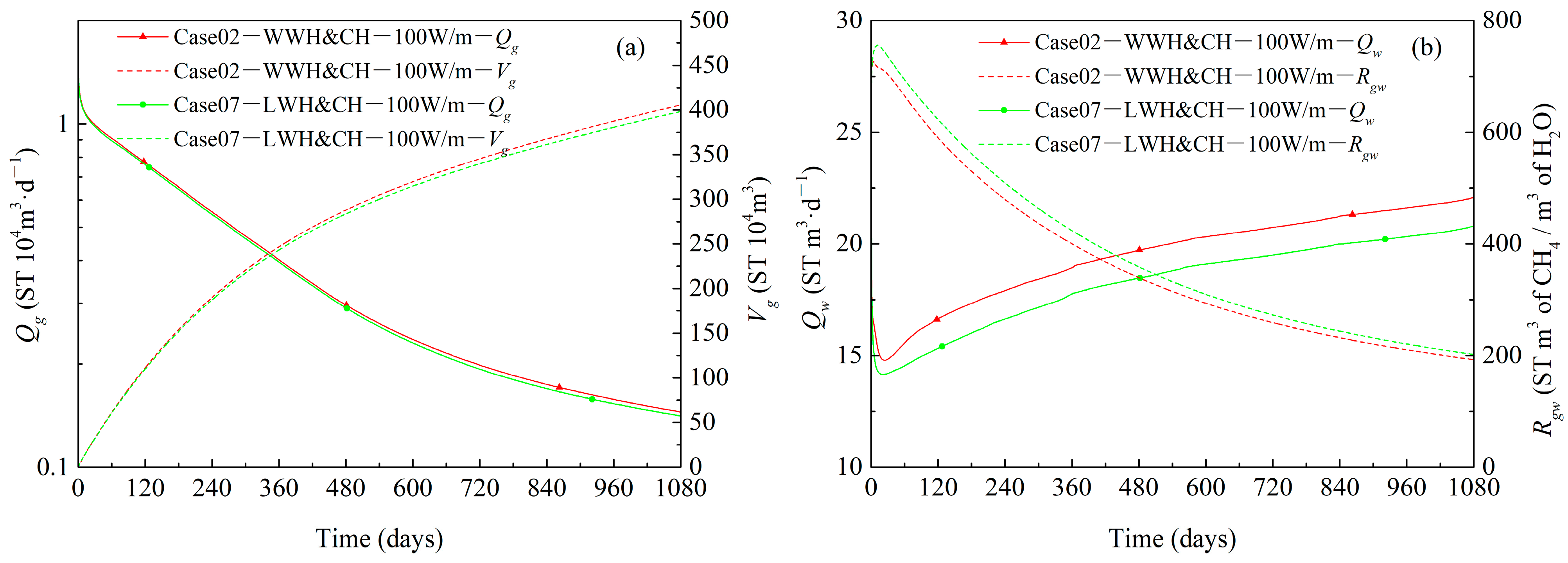
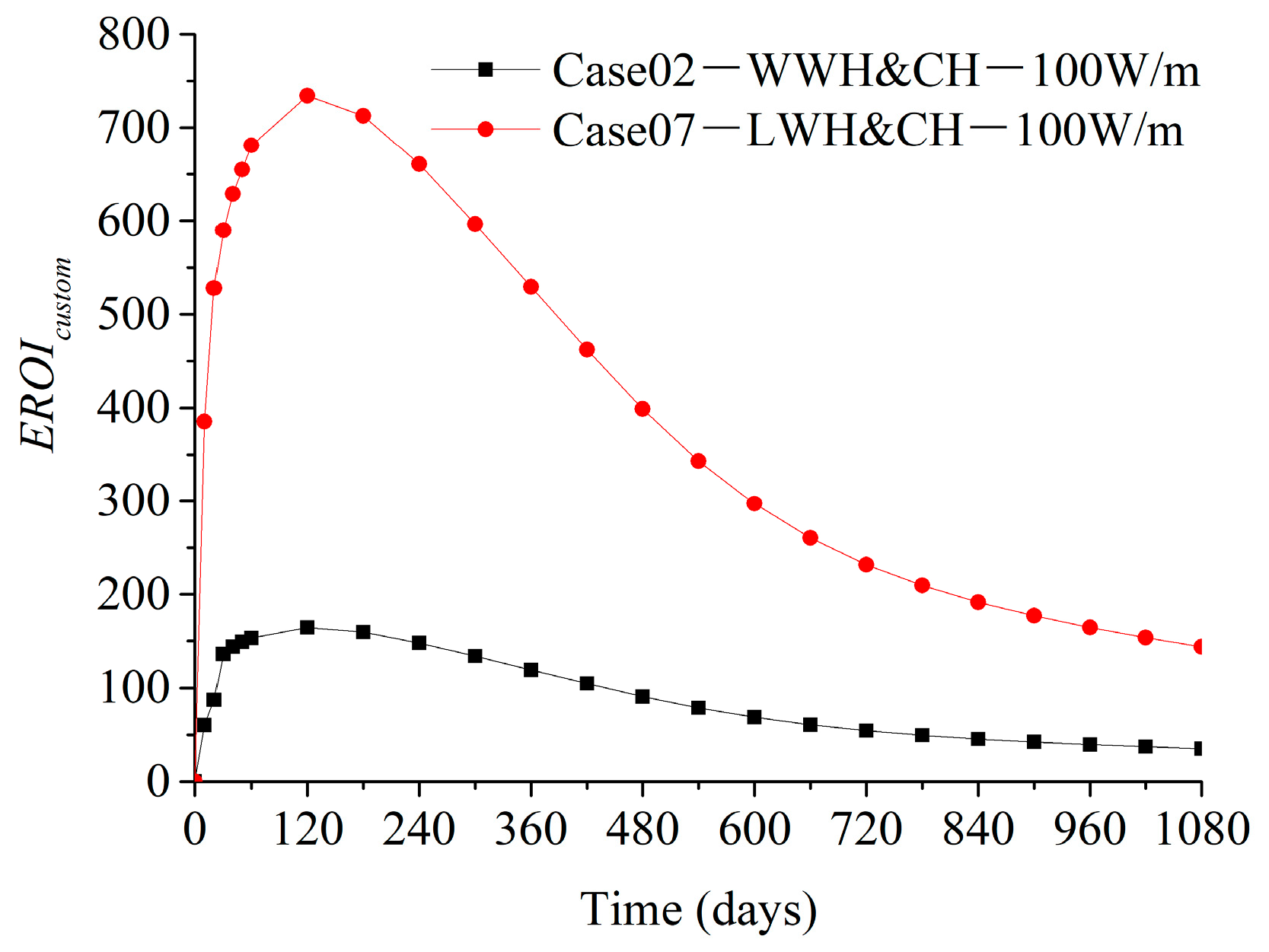
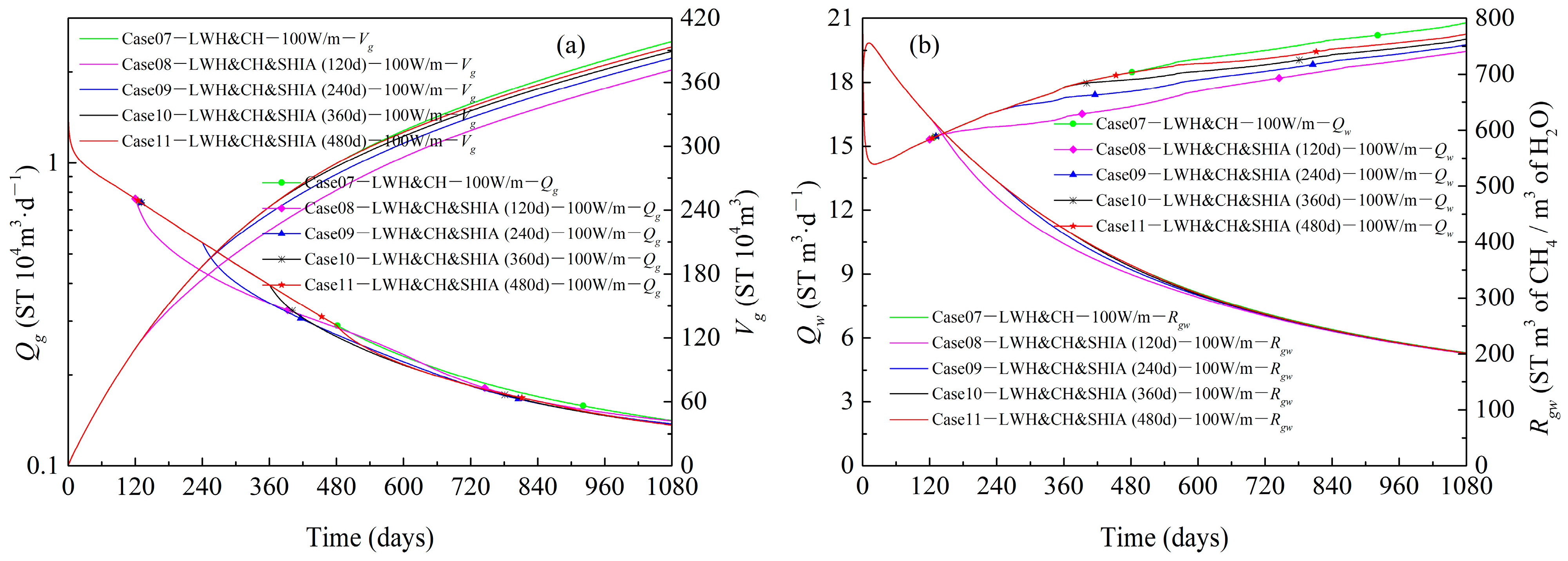
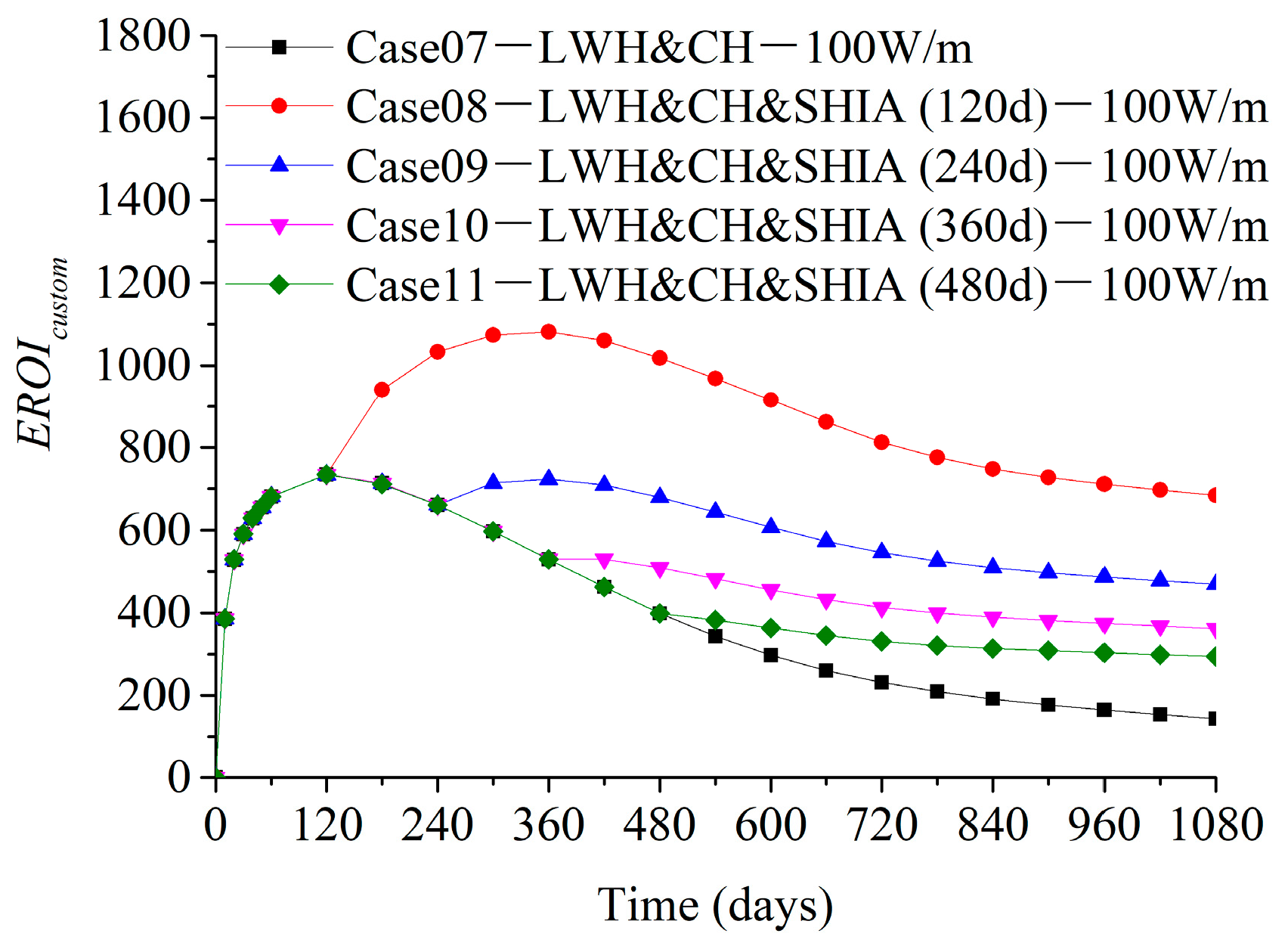
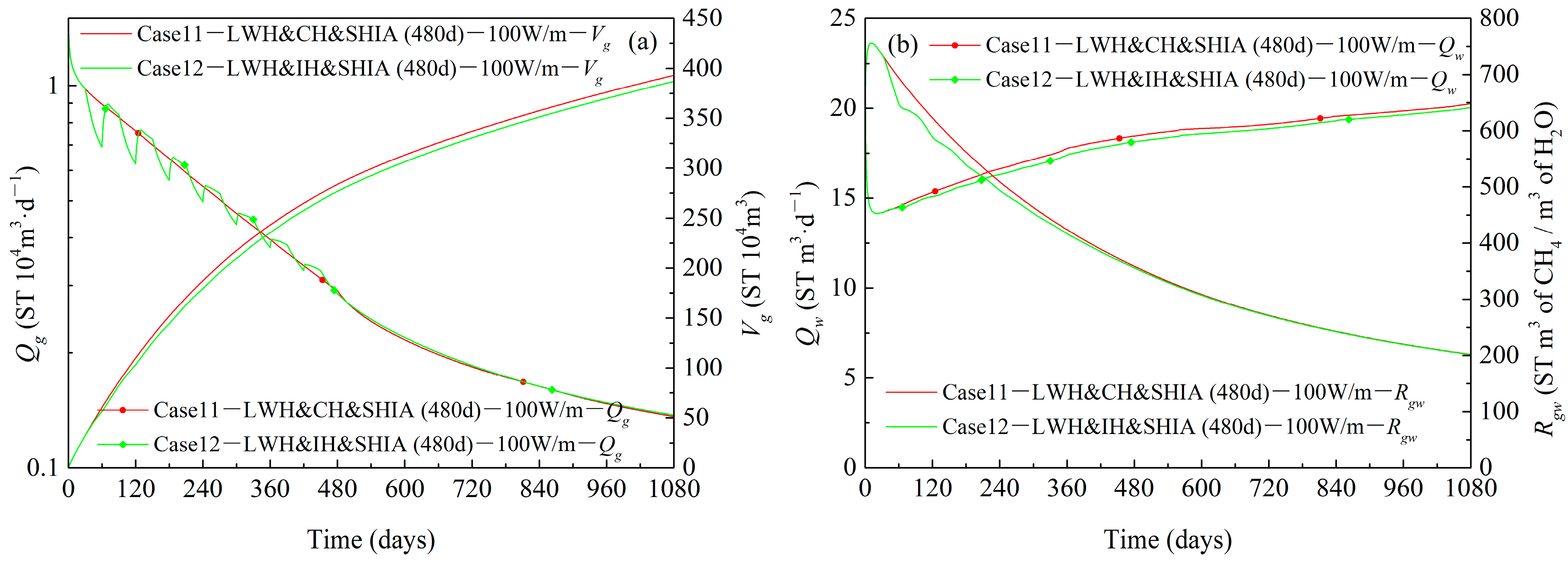

| ID | Heating Location | Heating Power | Heating Mode | Time to SHIA |
|---|---|---|---|---|
| Case 01 | - | - | - | - |
| Case 02 | WWH | 100 W/m | CH | - |
| Case 03 | WWH | 200 W/m | CH | - |
| Case 04 | WWH | 300 W/m | CH | - |
| Case 05 | WWH | 400 W/m | CH | - |
| Case 06 | WWH | 500 W/m | CH | - |
| Case 07 | LWH | 100 W/m | CH | - |
| Case 08 | LWH | 100 W/m | CH and SHIA | 120 d |
| Case 09 | LWH | 100 W/m | CH and SHIA | 240 d |
| Case 10 | LWH | 100 W/m | CH and SHIA | 360 d |
| Case 11 | LWH | 100 W/m | CH and SHIA | 480 d |
| Case 12 | LWH | 100 W/m | IH and SHIA | 480 d |
| Parameter | Value and Unit |
|---|---|
| OB and UB thickness [35,36] | 20 m |
| GHBL thickness [8,44,45,46] | 35 m |
| TPL thickness [8,44,45,46] | 15 m |
| FGL thickness [8,44,45,46] | 27 m |
| OB and UB initial permeability | 2.0 mD |
| GHBL initial permeability [8,44,45,46] | 2.9 mD |
| TPL initial permeability [8,44,45,46] | 1.5 mD |
| FGL initial permeability [8,44,45,46] | 7.4 mD |
| Wellbore radius [44,45,46] | 0.1 m |
| Salinity [44,45,46] | 3.5% |
| GHBL and TPL initial hydrate saturation [8,44,45,46] | Extracted from logging curve (Figure 2a) |
| FGL initial free gas saturation [8,44,45,46] | Extracted from logging curve (Figure 2a) |
| OB and UB porosity | 0.30 |
| GHBL porosity [8,44,45,46] | 0.35 |
| TPL porosity [[8,44,45,46] | 0.33 |
| FGL porosity [8,44,45,46] | 0.32 |
| Grain density [44,45,46] | 2600 kg/m3 |
| Geothermal gradient [44,45,46] | 43.653 °C/km |
| Grain specific heat [44,45,46] | 1000 J·kg−1·K−1 |
| Gas composition [44,45,46] | 100% CH4 |
| Dry thermal conductivity [24,44,45,46] | 1.0 W·m−1·K−1 |
| Wet thermal conductivity [24,44,45,46] | 3.1 W·m−1·K−1 |
| Composite thermal conductivity [24,44,45,46] | KΘ = kdry + (SA1/2 + SH1/2)(kwet − kdry) + φSIλI |
| Capillary pressure model [24,44,45,46] | |
| Maximum reference aqueous saturation SmxA [24,44,45,46] | 1 |
| Porosity distribution index λ [24,44,45,46] | 0.45 |
| Initial capillary pressure P0 [24,44,45,46] | 104 Pa |
| Relative permeability model [24,44,45,46] | KrA SirASirASirGSirA)]nG |
| Permeability reduction index for aqueous nA [24,44,45,46] | 3.5 |
| Permeability reduction index for gas nG [24,44,45,46] | 2.5 |
| Residual gas saturation SirG [24,44,45,46] | 0.03 |
| Residual aqueous saturation SirA [24,44,45,46] | 0.30 |
| Permeability reduction model [24,44,45,46] | |
| Critical porosity φc [24,44,45,46] | 0.05 |
| Permeability reduction index n [24,44,45,46] | 3 |
Disclaimer/Publisher’s Note: The statements, opinions and data contained in all publications are solely those of the individual author(s) and contributor(s) and not of MDPI and/or the editor(s). MDPI and/or the editor(s) disclaim responsibility for any injury to people or property resulting from any ideas, methods, instructions or products referred to in the content. |
© 2024 by the authors. Licensee MDPI, Basel, Switzerland. This article is an open access article distributed under the terms and conditions of the Creative Commons Attribution (CC BY) license (https://creativecommons.org/licenses/by/4.0/).
Share and Cite
Wan, T.; Li, Z.; Lu, H.; Tian, L.; Wen, M.; Chen, Z.; Li, Q.; Qu, J.; Wang, J. Numerical Simulation of Vertical Well Depressurization-Assisted In Situ Heating Mining in a Class 1-Type Hydrate Reservoir. Appl. Sci. 2024, 14, 6203. https://doi.org/10.3390/app14146203
Wan T, Li Z, Lu H, Tian L, Wen M, Chen Z, Li Q, Qu J, Wang J. Numerical Simulation of Vertical Well Depressurization-Assisted In Situ Heating Mining in a Class 1-Type Hydrate Reservoir. Applied Sciences. 2024; 14(14):6203. https://doi.org/10.3390/app14146203
Chicago/Turabian StyleWan, Tinghui, Zhanzhao Li, Hongfeng Lu, Lieyu Tian, Mingming Wen, Zongheng Chen, Qi Li, Jia Qu, and Jingli Wang. 2024. "Numerical Simulation of Vertical Well Depressurization-Assisted In Situ Heating Mining in a Class 1-Type Hydrate Reservoir" Applied Sciences 14, no. 14: 6203. https://doi.org/10.3390/app14146203
APA StyleWan, T., Li, Z., Lu, H., Tian, L., Wen, M., Chen, Z., Li, Q., Qu, J., & Wang, J. (2024). Numerical Simulation of Vertical Well Depressurization-Assisted In Situ Heating Mining in a Class 1-Type Hydrate Reservoir. Applied Sciences, 14(14), 6203. https://doi.org/10.3390/app14146203





